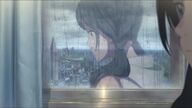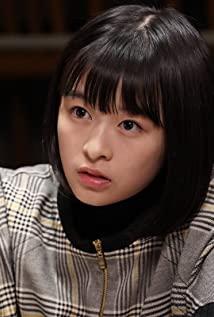Also Talk About Japanese Folklore You Don't Know in "Weathering With You"
Qingnv may be "Qingniang"
In "Weathering With You", the heroine Yang Na is known as the 100% Sunny Girl, who has the super power of praying to make the sky clear. In Japan, there is indeed a saying of Qingmen and Qingnv, and variety shows will also use this as a topic to do programs, and the spread of similar superstitions to China has also made Xiao Jingteng's rain boy terrier enduring.
In the middle of the story, Yang Cai told the hero Fan Gao that Qi Qing's ability was at the expense of himself. The god of the weather shrine also said that in the history of long-term rain disasters, all weather witches with superpowers prayed to the dragon god. In the end, the weather witch sacrificed in exchange for a normal climate. After that, it did indeed exchange for Tokyo with the disappearance of Haruna. The rainstorm stopped.
The prototype of this story may come from China.
In the "Beijing Traditional Culture Handbook" published in 1992, a large number of Beijing's customs and geographical evolution were recorded. In the chapter of "Legend of the Palm", a legend called "Qing Niang" is included:
"According to legend, in ancient times, there was a beautiful girl in Beijing called Qingniang, who was ingenious and good at paper-cutting. She was famous for her flower-cutting, and even the empress and princess in the palace often sent people to buy her paper flowers. In the month, it rained heavily and it was not sunny for several days. The capital was flooded by three feet, and the people burned incense and kowtowed to no avail. At night, Qing Niang was sitting on the collapsed roof and praying. Suddenly, a loud noise was heard, and the Dragon King of the East China Sea sent a message, especially Yingqingniang is the crown princess. If she doesn't obey, the capital will be flooded. In order to save the villagers, Qingniang obeys the order of heaven. After a whole strong wind, Qingniang disappeared and the sky cleared. In order to commemorate Qingniang, every June On the cloudy day, the daughters in the boudoir were ordered to make paper-cutters and hang them at the front of the door, so they were called 'Sao Qing Niang'."
The key elements of "Qing Niang" are very similar to "Weathering Son": in midsummer, there is a city with constant rainstorms, a girl who has the ability to pray for clearness, the object of praying for clearness is the Dragon King, and the price of praying for clearness is the disappearance of the girl, in order to save the common people sacrifice yourself...
When Xin Haicheng conceived the plot, he should have referred to the story of "Qing Niang", which is the source of this title. (For the specific research process and auxiliary evidence, please refer to: https://www.zhihu.com/question/353742582/answer/908879356 )
Returning to "Qing Niang" itself, this story is not recorded in other classics. The core plot of "a girl who needs to pay tribute to the water god to relieve the flood" is similar to the widely circulated legend of Hebo's wife in China. It is reasonable to guess that this is a product that was grafted with the traditional story of Hebo's wife in order to explain the ancient northern folk custom of "Sao Qingniang".
Sunny Doll and Sweeping Girl
In "Weathering With You", in order to help Yangna pray for the sunshine, Hodaka made her an umbrella full of sunny dolls. Whenever Hina uses her ability to pray, Hina's younger brother, Nagi, will forcefully turn the umbrella, making the sunny doll dance along with it, completing the prayer ceremony together.
Older Chinese are not unfamiliar with Sunny Day Dolls. After all, "Smart Yixiu" is a childhood classic of a generation. The sunny doll in Japanese is "zhao る Zhao る Fangzhu" , that is, the meaning of the sunny monk, because in the Japanese concept, praying for the rain is the work of the monk, and the shape of the bare little doll is also similar to the monk.
The origin of the Qingtian doll originated in China's Qing Niang, a custom widely popular in the north. The earliest written record is in the poem "The Sweeping Lady" in the Yuan Dynasty: "Rolling up the sleeves and holding the clothes, holding a broom, and hanging it to the cloudy sky, then shaking hands." The Ming Dynasty's "Scenery of the Emperor's Capital" and the Qing Dynasty's "Yu Yu Cong Kao" "Yanjing Sui Ji Ji" is also mentioned.
On days when the rain does not stop, people will cut paper-cuts in the shape of a woman holding a broom, and hang it under the eaves or beside the door, which is called Sao Qing Niang. For those who are more particular, they need to use white paper as the head, red and green paper as clothes, and tie the seedlings into a small broom. If the prayer is successful, they are taken off and burned.
Sweeping Mother is essentially a kind of simulated witchcraft, replacing witches with paper figures and sweeping away the dark clouds with a broom. The ancients hoped to use a similar shape to achieve the purpose of praying for sunshine.
After the Ming Dynasty, the folklore of Qing Niang was introduced to Japan and became a sunny doll in the shape of a monk.
In the middle of the Edo period, sunny dolls had already spread in Japan. A simple doll with a round head hangs under the eaves by the window, dancing with the wind and rain, praying for the rain to stop. If it is sunny the next day, it must be painted with eyes, soaked in divine wine, and washed away in the river.
Ride a fairy horse across the Obon
When Hodaka and Haruna came to the roof shrine, the camera specially showed the eggplant cow and cucumber horse on the ground. Friends who often watch Japanese comics are probably no strangers. These two are called "elf horses", which are customs during the Obon festival in Japan. And Taki Taki's grandmother was also burning fire when she appeared, and her wish was to hope that it would not rain during the Obon Festival.
So what are the interesting customs of Obon?
The name of the Obon festival comes from the Buddhist Obon festival. When the Buddhist dharma assembly was mixed with the Chinese Taoist Zhongyuan Festival ancestor worship custom, and then spread to Japan, it became the most solemn traditional festival in Japan except for the New Year, the Obon Festival. (Japanese: おpen).
In the past, the Obon Festival in Japan was on July 15 of the lunar calendar, but after the Meiji Restoration, it was changed to July 15 of the Gregorian calendar. And because July is the busy season for farming, the official holiday in Japan was later set on August 15 of the Gregorian calendar, and the time of the festival was different in different places.
The 1st day of the month of Obon is known as the "Ku Gai Shuo Day", and it is also the day when the Japanese believe that the gates of hell are opened and the soul returns home. From this day on, the Obon Festival officially begins. On the evening of the 7th, it was necessary to arrange the shed flags, that is, the small table "elf shed" for placing tributes and the prayer flags to welcome the dead, which later evolved into the bamboo and wishing flags of the Qixi Festival.
On the 13th, the fire was greeted. Tributes were placed on the elf shed. The elf horses made of wooden sticks, eggplants and cucumbers were also placed at this time. The slender and light cucumber horse symbolizes the spirit of the deceased to return home quickly on a horse, and the heavy and stocky eggplant cow means the slow return of the cow, expressing the mourning of the living who expect the soul of the deceased to stay in the world for a longer time.
The 16th is the fire-offering day. During the fire-offering day, all places will be lit with lights. Or the lighting of water lanterns, or thousands of lanterns, or a magnificent scene like the fire sent by the Great Five Mountains in Kyoto. There will also be a festival on the evening of the 16th. On the night of the full moon, people dance in the basin, imitating the scene of the celebration and dance of the souls who have survived in hell.
The weather shrine has no dragons
In "Weathering With You", Keisuke, voiced by Shun Oguri, and his niece Natsumi came to the Weather Shrine to investigate the legend of the Weather Miko. In the shrine, they saw the giant dragon painted on the ceiling. The old god master introduced that the weather witch had prayed to the dragon god for 800 years.
In fact, Japan does have a weather shrine, which it claims is "the only one in the country". But if you want to go here for a Holy Land tour, you will probably be disappointed.
The Meteorological Shrine is located in the Glacier Shrine in Koenji, Tokyo, which is equivalent to a separate place in the Glacier Shrine as a meteorological shrine. The real "weather shrine" is so small that it doesn't even have a formal shrine, just a simple torii gate and shrine. The only thing that has appeared in the animation is the geta-shaped ema that is featured here.
Why is "the only meteorological shrine in the country" so messed up?
It turned out that the Meteorological Shrine was an internal construction established in 1944 by observers of the Japanese Army Meteorological Department in order to pray for accurate weather forecasts. The original site was in the Maqiao area of Suginami District. After the war, Japan stripped the religious color from the national institutions, and only the small "weather shrine" was omitted from the statistics. This internal superstition that originally existed among the staff has survived, and it has become a mini shrine in a decent manner.
In 2003, due to the damage of the original site, the Meteorological Shrine was relocated to the current Hikawa Shrine, and special souvenirs such as the clog-shaped Ema and the Meteorological Goshu Seal with different patterns on a daily basis were also created.
Therefore, the Dragon God Patio in "Weathering With You" is actually the work of the film's art director, Yamamoto Tsubasa.
Although I can't see the real one, there are still "high imitation versions" to watch. In the hall of Kennin Temple in Kyoto, there is also a patio full of "Double Dragons", which was painted by the painter Koizumi Junzo in 2002 when the temple was 800 years old. As soon as you enter the door, you can see the powerful paintings on the roof, and the experience is no worse than the movie.
On this website in Japan , we have collected all kinds of temples in Japan with dragon god patios, and share the screenshots. If you are interested, you can click here to see the details~
Related URLs:
Meteorological Shrine official website: https://koenji-hikawa.com/kisho_jinja/ (you can see the souvenirs they make, they are all cute)
Knowing Monsters (Hundred Collections of Chinese Monsters): http://www.cbaigui.com/ (a website that collects Chinese monsters by category)
(First published in "Museum Magazine", reprinting without permission is prohibited)
View more about Weathering with You reviews











